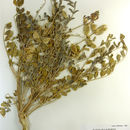Comprehensive Description
provided by North American Flora
Phaca crotalariae Benth. PI. Hartw. 307. 1848
Astragalus Crotalariae A. Gray, Proc. Am. Acad. 6: 216. 1864. Tragacantha Crotalariae Knntze. Rev. Gen. 243. 1891. Astragalus limatus Sheldon. Minn. Bot. Stud. 1: 126. 1894. Astragalus Preussii limatus Jepson, Man. Fl. PI. Calif. 566. 1925.
Perennial, with a taproot, but evidently blooming the first year; stems several, 3-6 dm. high, strongly sulcate, pubescent, at least when young, with ascending hairs; leaves 10-15 cm. long, ascending; stipules ovate-deltoid, reflexed, free, 5-6 mm. long; leaflets 11-19, roundedobovate, rounded or retuse at the apex, 1-3.5 cm. long, pubescent beneath with ascending hairs; peduncles 1-1.5 dm. long, ascending; racemes 6-10 cm. long; bracts ovate or ovate-lanceolate, 3 mm. long; pedicels 2 mm. long; calyx strigose, the tube cylindric, about 7 mm. long, the teeth lanceolate, 2 mm. long; corolla purple, about 2 cm. long; banner obovate, retuse, slightly arched; wings shorter, the blade oblong, slightly falcate, longer than the claw, with a large basal auricle; keel-petals similar but broader and more arched; pod short-stipitate, strigulose and crossveined, the stipe 2 mm. long, obconic, the body rounded-ellipsoid or ovoid, 2.5-3 cm. long, 15-18 mm. wide and thick; seeds obliquely reniform, 4 mm. long, 2.5 mm. broad, brown.
Type locality: Monterey, California (that of .4. limatus: Indian Wells, Colorado Desert, California).
Distribution: Southern California and northern Lower California.
- bibliographic citation
- Per Axel Rydberg. 1919. (ROSALES); FABACEAE; PSORALEAE. North American flora. vol 24(1). New York Botanical Garden, New York, NY
Physical Description
provided by USDA PLANTS text
Annual, Herbs, Stems woody below, or from woody crown or caudex, Taproot present, Nodules present, Stems erect or ascending, Stems less than 1 m tall, Stems solid, Stems or young twigs sparsely to densely hairy, Leaves alternate, Leaves petiolate, Stipules conspicuous, Stipules membranous or chartaceous, Stipules persistent, Stipules free, Leaves compound, Leaves odd pinnate, Leaf or leaflet margins entire, Leaflets opposite, Leaflets 5-9, Leaflets 10-many, Leaves hairy on one or both surfaces, Inflorescences racemes, Inflorescence axillary, Bracts very small, absent or caducous, Flowers zygomorphic, Calyx 5-lobed, Calyx glabrous, Petals separate, Corolla papilionaceous, Petals clawed, Petals red, Petals bl ue, lavander to purple, or violet, Banner petal narrow or oblanceolate, Wing petals narrow, oblanceolate to oblong, Wing tips obtuse or rounded, Keel petals auriculate, spurred, or gibbous, Keel tips obtuse or rounded, not beaked, Stamens 9-10, Stamens diadelphous, 9 united, 1 free, Filaments glabrous, Style terete, Style persistent in fruit, Fruit a legume, Fruit unilocular, Fruit freely dehiscent, Fruit oblong or ellipsoidal, Fruit or valves persistent on stem, Fruit exserted from calyx, Fruit inflated or turgid, Fruit beaked, Fruit glabrous or glabrate, Fruit hairy, Fruit 11-many seeded, Seeds cordiform, mit-shaped, notched at one end, Seed surface smooth, Seeds olive, brown, or black.
Astragalus crotalariae: Brief Summary
provided by wikipedia EN
Astragalus crotalariae is a species of milkvetch known by the common name Salton milkvetch. It is native to the Colorado Desert in California and other Sonoran Deserts in Arizona and northern Mexico. It grows in desert scrub habitat, including the Salton Sink in the Coachella Valley.
- license
- cc-by-sa-3.0
- copyright
- Wikipedia authors and editors

